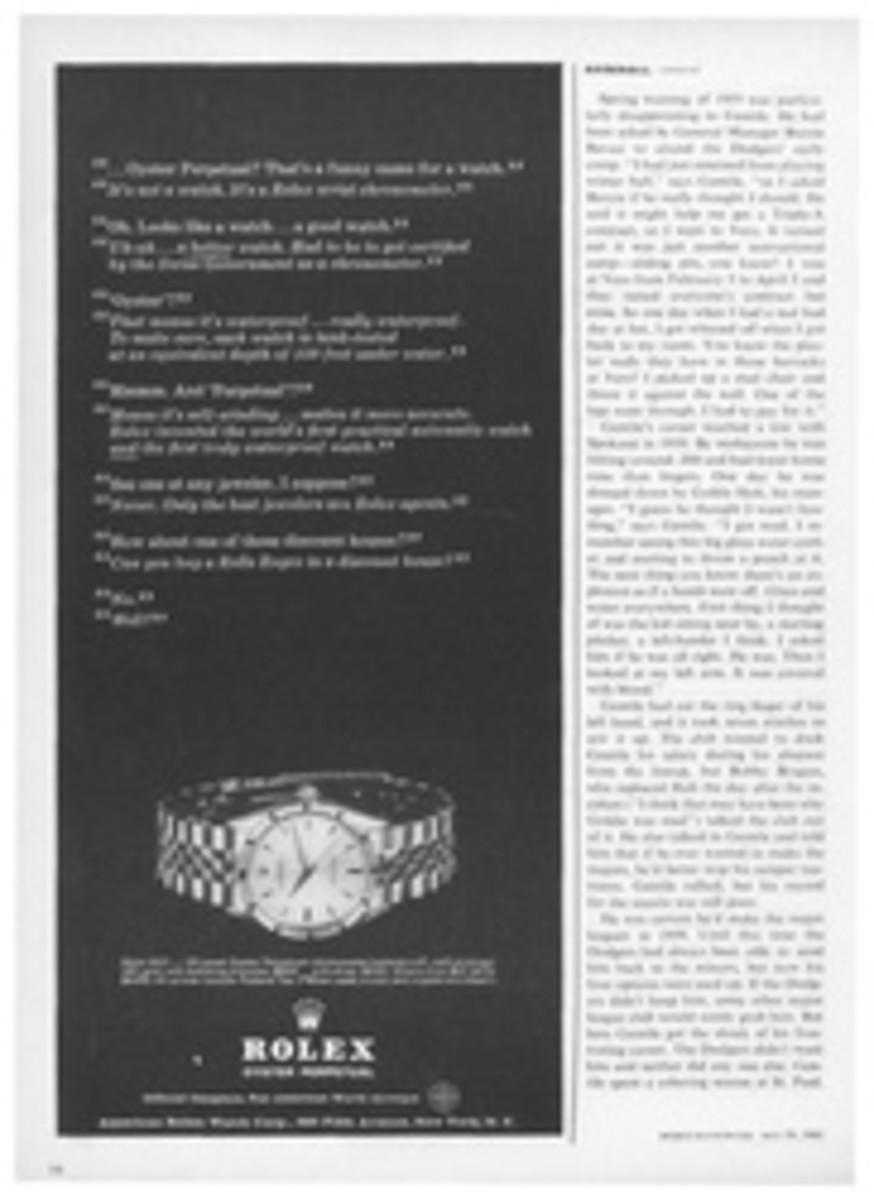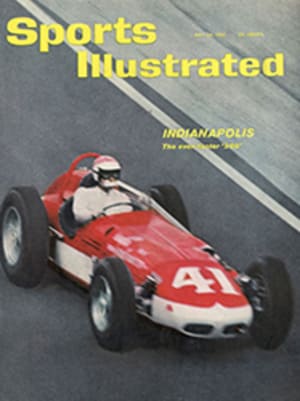
BRITISH BULLET AT INDY
Almost everything will seem very much as usual next Tuesday when some 250,000 persons assemble at Indianapolis for the annual 500-mile auto race, but one thing will make the occasion very different: the presence of the small, green British bullet shown below. Lurking five rows down in pole position as the 33 cars line up for this 45th running of America's greatest race, this Cooper-Climax adaptation of a Grand Prix racer will pose a hard, new question, which all the color and clamor of Indy on Memorial day will not be able to smother: Is the time-honored Indianapolis roadster (see cover) still master of the Brickyard, or is it merely an expensive fossil soon to be pulverized by intruders from overseas?
Indianapolis has already been profoundly shaken by the little British upstart. Despite an engine only two-thirds the size of the big Indy Offenhausers and a design conceived basically for road racing, quite different from American-style track racing, it was qualified easily by Australia's World Champion Driver Jack Brabham. It is the first foreign car since 1952 to make the "500" starting field. Should it overcome heavy odds and actually win the race, it will be the first to do so since the Italian Maseratis driven by Wilbur Shaw in 1939 and 1940. In any case, it will surely encourage other foreign entrants to come and fight for future "500" purses. The purse this year may well reach $400,000, a figure undreamed of in European racing.
Moreover, the Cooper has one successful revolution already to its credit as it sits on the line in the Brickyard. The British car is fundamentally the same Cooper-Climax with which its beef-loving, pipe-smoking builder and owner, John Cooper, turned international Grand Prix racing frontside-back two years ago. After Cooper's rear-engined car won the 1959 world championship, his rivals abruptly discarded their front-engined designs and put their engines in the rear, where all Grand Prix cars have them now.
That happened overseas, however, and those distant convulsions caused hardly a tremor at Indianapolis. The "500" race was thought to be as remote from the Grand Prix sport as baseball from cricket. Sporadic and mostly ill-planned postwar foreign ventures in the "500" have been futile, and for 20 years the Indy men have remained in their well-worn groove.
No designer appeared to dispute the basic roadster introduced in 1952 by Frank Kurtis, whose greatest innovations were to offset the engine to the left side of the chassis, compensating for the Speedway's four left turns, and drop the driver down beside the drive shaft from his old perch above it. Only the fragile Novisupercharged V-8 interrupted the complacent routine of Meyer-Drake, builders of the long-dominant Offy engine—and then only slightly. Nor did any competitor threaten Ted Halibrand, who cornered nearly all the wheel, rear axle and differential business, or Firestone, who year after year could confidently predict that the winning car would ride on their tires—no other manufacturer built "500" tires.
Thus the simple front-engined, solid-axle Indianapolis car became, as one insider puts it, a catalog item. A new one cost between $25,000 and $30,000. The price was steep, but after all the roadster was the best of all possible cars for the extremely special tasks assigned to it: to accelerate violently away from the Speedway's turns, and be beefy enough not to break should it kiss a concrete retaining wall.
Then Cooper and Brabham happened by Indianapolis last fall on the way to an American road race. They warmed up for some trial laps, and suddenly the far-off thunder reverberated here at home, for Brabham reached an astonishing lap speed of 144.8 mph with a pure Grand Prix Cooper-Climax car. Brabham also cornered brilliantly whether in or out of the "groove," the Americans' fastest safe line through the turns. Indy roadsters out of the groove at extreme speed are in immediate danger of crashing.
Instantly the question rose from America's Grand Prix and sports car fans who have long, and rather blindly, looked down their noses at the Brickyard: Why not try? But wait, said John Cooper. I am not a well-heeled revolutionary. My shop is as modest as my manner. I can't possibly afford to enter your race on my own. If I am to subvert the Indianapolis tradition, I must have financial backing.
And lo, a financial angel appeared, an American with silver hair and a small gold earring in his right ear lobe. James (Gentleman Jim) Kimberly, the footloose millionaire who road-raced Ferrari sports cars in the mid-1950s, offered to underwrite the entire cost of building a special Cooper-Climax for the "500" as well as all attendant expenses. His offer accepted, he set up a $30,000 drawing account for Cooper.
Low-priced sedition
Rarely has such potent sedition cost so little. There was a certain amount of grumbling that Cooper had been permitted to enter a car with only 92 inches of wheelbase, rather than the 96 inches required of home-bred cars. But the British builder was merely taking advantage of a Speedway rule written long ago to stimulate foreign competition. In any case he wasn't counting primarily on the wheelbase exemption. More important, he wanted a chance to demonstrate the worth of a rear-engined car in a race heretofore devoted to front-engined designs.
The Cooper's Coventry-Climax engine, stretched to 2.75 liters by boring and stroking last year's standard 2.5-liter Grand Prix engine, produces only 252 horsepower, while the 4.2-liter Offies yield 400. But the entire car weighs only 1,050 pounds, or 500 pounds less than the lightest Indy roadster. Consequently, its vital power-to-weight ratio is competitive. Suspension is independent for all four wheels, and the Cooper's frontal area has the typically low, wind-cheating form that no front-engined car can approach. The engine has been tipped to the left, some chassis hardware has been altered to suit the continual left-hand turning, and the tires are the British Dunlop firm's hastily produced answer to Cooper's plea for special Indy tires, which Firestone, in sportsmanlike fashion, agreed to mount and maintain.
Given this car, Brabham proved that he could take the Speedway's sweeping turns, in which the "500" is won or lost by American drivers, at the highest speeds yet recorded—one unbelieving observer clocked him at 143-plus mph through one of the bends.
Thus, Brabham soon joined the elite group of drivers surpassing 146 mph. Then he flew to Monte Carlo on the first leg of an ocean-hopping binge unparalleled in racing—first to qualify in the Monaco Grand Prix, then to qualify at Indianapolis, then back to race at Monaco, race in the Dutch Grand Prix and, finally, reappear at Indy in time for the "500." He took this eye-popping schedule casually. "I've always wanted to see this race," he said cheerfully. "This is the best way of doing it, isn't it?"
Brabham qualified on the first of the Speedway's four qualifying days at the good speed of 145.144 mph, earning the fifth-row pole in the 11-row, three-abreast starting lineup. Then he was off for Monaco (where engine misfunctioning caused his retirement) and was momentarily forgotten as the rest of the 33-car field began to emerge from the qualifying runs. An amazing crowd—more than 150,000 persons—looked on. Some sat close by the spot where the former national champion, Tony Bettenhausen, had crashed and died the day before. (Satisfied that the track's wall, fence and protective cable complex had held up under the impact of Bettenhausen's car, officials planned no new bulwarks.)
On the track itself, speeds inched up over last year's record averages. Talkative Eddie Sachs won the pole for the second straight year. In Gasoline Alley, Builder-Mechanic A. J. Watson sweated to repair Rodger Ward's suddenly sick engine. Subsequently, Ward, the 1959 winner and Tuesday's cofavorite with Jim Rathmann, last year's champion, qualified handily. Rathmann was a shade slower.
But amid the speed and exhaust noise of the Brickyard no one could quite forget the little Cooper. It took no leap of the imagination to judge what dislocations might come about if two or three other European factories, jolted out of their former timidity, should in the future join Cooper in full-scale warfare at Indianapolis. For example, Enzo Ferrari, the Italian wizard, builds bigger, hotter engines than any available to John Cooper in Britain and tremendously reliable racing cars.
Threat to investments
The harsh truth is that American racing design is not only stagnant, it is virtually nonexistent. Additionally, the 50-odd Indianapolis car owners are by no means eager to have their immense investments in the roadsters suddenly threatened.
But whether the owners like it or not, certain facts must be acknowledged. One owner willing to do so is Jack Zink, 32, the boy wonder whose cars won in 1955 and 1956. An engineering graduate, Zink manufactures industrial furnaces at Tulsa. He is known as a man who likes to wear a mechanic's smock (see below) and get his hands dirty working on his cars. He is also known as something of a maverick. Right now he is shaping his own challenge to the roadsters by building a rear-engined, independently sprung turbine racer. It should be ready next year. Meanwhile, Zink is campaigning a roadster. It will be driven by big Troy Ruttman, the 1952 winner, a man who is never afraid to use his throttle foot.
An owner who probably will go along with changing times, if not go far to meet them, is J. C. Agajanian. Son of an immigrant Armenian goatherd who vaulted in station from $1-a-day dishwasher to wealthy West Coast hog rancher, Agajanian is a Stetson-wearing extrovert with a sharp business eye. Just now Agajanian tends to defend the status quo, but within five years he expects to build a $15 million, super-Indianapolis track in the Los Angeles area. When that time comes, he undoubtedly will seek the freshest and fastest cars available, regardless of nationality. His driver is Rufus Parnell (Parnelli) Jones, a smooth and rapid newcomer.
No one knows how many owners are prepared to resist radical change at any cost. When the conservative wing forms ranks it will most likely be led by Lindsey Hopkins. Probably the wealthiest of the wealthy Indianapolis owners, he is a director of Coca-Cola and member of the family controlling a rich land-development firm.
"I have put," says Hopkins, "10 years of investment, hard work, heartache and tears into this plant. If it now develops that our cars are obsolete, some of us would seriously have to consider quitting the sport."
For Builder Watson, however, whose roadsters have won four of the last six races, the Cooper's appearance had the effect of releasing pent-up energies. "I'm glad it's here," he said. "For years we've been scared to try anything new. Now we are simply going to have to."
PHOTO
JOE CLARK
CORNERING BRITAIN'S COOPER-CLIMAX AT INDIANAPOLIS, GRAND PRIX CHAMPION JACK BRABHAM IS COOLLY EFFICIENT AS HIS LIGHTWEIGHT CAR GOES AFTER INDY'S MOST CHERISHED—INDEED, ONLY—RACING DESIGN
PHOTO
JOE CLARK
DEFENDING CHAMPION JIM RATHMANN LEADS U.S. PROS
PHOTO
JOE CLARK
AUSSIE INTRUDER JACK BRABHAM IS OUT TO CRACK U.S. MONOPOLY
THREE PHOTOS
JOE CLARK
U.S. CAR OWNERS CHALLENGED BY COOPER INCLUDE CHIPPER J. C. AGAJANIAN, SERIOUS JACK ZINK AND ANXIOUS LINDSEY HOPKINS

